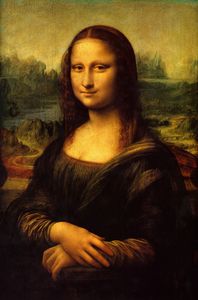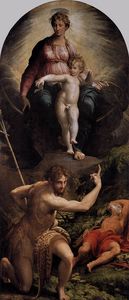Antea
- Date of Creation:
- circa 1534
- Alternative Names:
- Portrait of a Young Woman, Portrait of Antea, Beloved of Parmigianino
- Height (cm):
- 136.00
- Length (cm):
- 86.00
- Medium:
- Oil
- Support:
- Canvas
- Subject:
- Figure
- Art Movement:
- Mannerism
- Created by:
- Current Location:
- Naples, Italy
- Displayed at:
- National Museum of Capodimonte
- Owner:
- National Museum of Capodimonte
Antea Story / Theme
Parmigianino's Antea has fascinated art historians for centuries and is considered by many to be one of the finest examples of Italian female portraiture. Arguably the second-most enchanting and mysterious portraits of the Renaissance after the Mona Lisa, this work intrigues art fans and critics as very little is known about why the painting was commissioned or the identity of the sitter. All that is known is that the artwork was painted when Parmigianino made his final return to Parma.
Antea is rich in symbolism, from the fine clothing and jewelry to the odd proportions and suggestiveness of the subject's body. Parmigianino has created an odd and boldly confident beauty that fixes the viewer with her audacious gaze.
Like the Mona Lisa, Antea has the same, almost fierce eye contact with the viewer and she too appears enigmatic and unattainable.
The painting was only given the name 'Antea' in the 17th century after Parmigianino's death. Giacomo Barri named the portrait after a famous Roman courtesan in his 1671 work 'A Painter's Voyage through Italy'. In classical mythology Antea also relates to Aphrodite, the goddess of love, but there is no evidence to suggest Parmigianino would have chosen this name for his painting.
Antea Analysis
Composition:
It is not only Antea's skin and complexion which appear unnatural; her bodily proportions are out of sync. Her tiny, youthful, head is set upon an impossibly large, curvy, womanly body and her shoulders are too wide and slope off at unfeasible angles. Her one hand is elongated and tapered in the typical Mannerist style. If you examine her carefully the different parts of her body don't seem to match. Her eyes are so wide that you can even see the whites below her irises. Parmigianino has given the viewer a strange interpretation of beauty. Yet, despite her physical disproportions and anomalies her presence still dominates the picture and her forceful beauty shines through.
Facial features:
Parmigianino was a gifted portrait artist and could easily convey the emotions and personality of his subject. Antea's gaze seems to be ambiguous though; her piercing eyes are almost haughty and nonchalant. Her cool demeanor makes the viewer question what she would think of the viewing world.
The viewer feels as though the subject is directly looking at them and judging what she sees and her critical gaze brings to light thoughts about status and positions in society. The relationship between viewer and subject becomes blurred. Once again Parmigianino has managed to create an interesting illusionary effect in his painting; Antea is looking at the viewer in equal measure and intensity as that which they are looking at her.
Space:
Parmigianino has manipulated the space in the painting so nothing interrupts the interaction between Antea and the viewer.
Use of light:
The background is bare and dark, except for the shadows and light that illuminate her body. The outline of her figure is sharp and strong as if she could pop out of the picture at any moment. Her hands, breast and face are almost unnaturally smooth and have a marble-like quality; you get the impression that Antea could have been sculpted.
Antea Critical Reception
The unanswered questions surrounding Antea have fascinated art historians for centuries. Many have tried to unravel her mysteries, piecing together various theories ranging from the bizarre to the predictable. Below are some of the more credible theories that have been set out by art historians;
Famous courtesan/The artist's mistress :
The writer Giacomo Barri dubbed the portrait 'Antea' in 1671 because he claimed the sitter was Parmigianino's mistress. Antea at the time was the name of a famous sixteenth-century Roman courtesan. However, no hard evidence about whether Parmigianino had a lover or mistress has ever been uncovered. Antea's yellow gown would support this theory as it was a color that prostitutes were often forced to wear in Italian cities to separate them from other ladies. It did, however, later become a fashionable color for wealthy women.
Antea is dressed very luxuriously. Her many layers include a gold blouse, delicate white apron, an intricate satin dress, a fur sole and gloves. This is complemented by fine jewelry: earrings, a head broach and, in her right hand, a golden chain. These garments are all typical of the lavish gifts that a lover would have given to his mistress or a client to his courtesan. The way that Antea is touching the necklace seems to also hint towards a link between her jewels and desire or sexuality.
Daughter of a servant:
Although lacy aprons were fashionable for young aristocratic women at the time, some believe the apron to be a sign that the model was simply a maid dressed up in finery.
Young Aristocrat/Nobel Bride:
It was often common for wealthy families to commission a 'presentation' portrait of their daughter in order to help negotiate a marriage partner. However, it would be unusual for such a portrait to show such a sense of sensuality. Instead the girl's virtue and innocence would have been promoted. There is also no evidence of a family crest in the portrait.
The striking likeness between the face of Antea and the face of the angel closest to Madonna in Madonna with the Long Neck (see Related Paintings below) has not gone unnoticed by art historians. Both figures could have been based on the same member of the Baiardi family. But surely if the family had known who the girl was they would have just named her in Antea? The inability to find enough evidence to confirm any of the above theories has led many art historians to suggest that Antea could just be a depiction of ideal beauty.
Antea Related Paintings
Antea Artist
During the Renaissance the idea of an ideal beauty was a popular genre of portraiture. In these works the impossible beauty and the attributes of womanly virtue that she stood for were more important that the actual sitter or her existence. Often the portrayal of a beautiful woman was meant to represent the beauty of the painting and its artifice.
Having had its roots in the platonic conception of reality this representation of ideal beauty would mean that Antea's youth and beauty would be everlasting. This way of viewing Antea as an idea instead of as a human being does encourage us to ponder on the very relationship between desire and art.
Parmigianino recognized the potential of art in being able to transmit his ideas. The differing theories surrounding Parmigianino's Antea continue to fascinate art historians and are part of his lasting legacy.
One of the Italian Renaissance's great geniuses, Parmigianino was not afraid to push boundaries and break with convention; it was this daring streak that paved the way for other bold artists to continue in the same vein and therefore it is no wonder that contemporary art critics christened Parmigianino the 'Prince of Mannerism'.
Parmigianino incorporated the grace of Raphael and the great masters into his paintings, but he also created some highly original work.
Antea Art Period
The Mannerism movement was initially a reaction against Classism, and harmonious works of previous artists such Leonardo da Vinci, Michelangelo and Raphael. It was a style that was notable for its spatial incongruity and elongated forms. It played with the idea of artificial, rather than natural qualities within art.
The Mannerist movement developed around 1520 in either Florence or Rome and replaced the High Renaissance era. It lasted until around 1580 with the emergence of the Baroque style. Early Mannerist painters include Andrea del Sarto, Jacopo Pontormo and Rosso Fiorento.
Parmigianino had a massive stylistic influence on Mannerism and sixteenth-century graphic art in general. He successfully managed to combine in his work the graceful and elegant style of the great masters with a new sense of movement and a striving for a sensuous beauty beyond nature. Many of his paintings contain within them mysterious ambiguities and conceal strains and tensions of the time.
During his short career, Parmigianino completed a vast body of work, including small panels and large-scale frescoes, sacred and profane subjects, portraits, and drawings of scenes from everyday life and of erotica. He is also credited with inventing etching and was one of the first artists to engrave his own work, distributing it throughout Italy and northern Europe.
Antea Bibliography
To read more about Parmigianino please refer to the recommended reading list below.
• Ekserdjian, David. Parmigianino. Yale University Press, 2006
• Findlen, Paula. The Italian Renaissance: The Essential Readings (Blackwell Essential Readings in History), 2002
• Freedberg, Sydney. Parmigianino: His Works in Painting. Greenwood Press, 1971
• Gombrich, E. H. The Story of Art. London : Phaidon Press, Ltd. , 1995
• Loizeaux, Elizabeth Bergmann. Twentieth-Century Poetry and the Visual Arts, 2008
• Vaccaro, Mary. Parmigianino: The Paintings. Umberto Allenmandi, 2004














